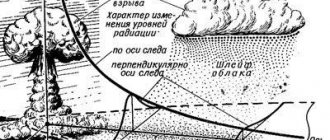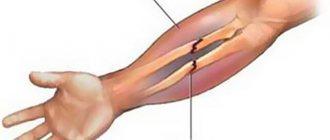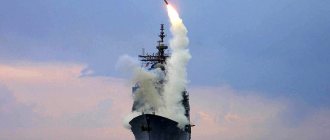At the beginning of the 20th century, thanks to the efforts of Albert Einstein, humanity first learned that, at the atomic level, a huge amount of energy can be obtained from a small amount of matter under certain conditions. In the 1930s, work in this direction was continued by the German nuclear physicist Otto Hahn, the Englishman Robert Frisch and the Frenchman Joliot-Curie. It was they who managed to trace in practice the results of the fission of the nuclei of atoms of radioactive chemical elements. The chain reaction process simulated in laboratories confirmed Einstein’s theory about the ability of a substance in small quantities to release large amounts of energy. In such conditions, the physics of a nuclear explosion was born - a science that cast doubt on the possibility of the further existence of earthly civilization.
The Birth of Nuclear Weapons
Back in 1939, the Frenchman Joliot-Curie realized that exposure to uranium nuclei under certain conditions could lead to an explosive reaction of enormous power. As a result of a nuclear chain reaction, spontaneous exponential fission of uranium nuclei begins and a huge amount of energy is released. In an instant, the radioactive substance exploded, and the resulting explosion had a huge damaging effect. As a result of the experiments, it became clear that uranium (U235) can be converted from a chemical element into a powerful explosive.
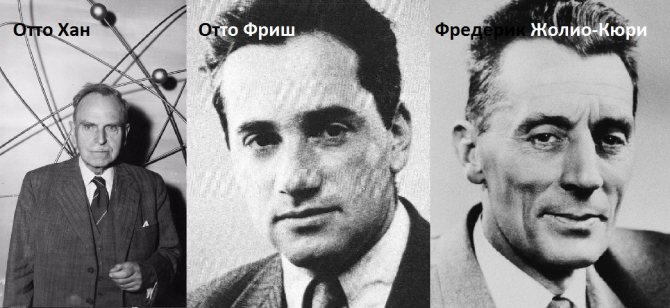
For peaceful purposes, when a nuclear reactor is operating, the process of nuclear fission of radioactive components is calm and controlled. In a nuclear explosion, the main difference is that a colossal amount of energy is released instantly and this continues until the supply of radioactive explosives runs out. The first time a person learned about the combat capabilities of the new explosive was on July 16, 1945. While the final meeting of the Heads of State of the victors of the war with Germany was taking place in Potsdam, the first test of an atomic warhead took place at the Alamogordo test site in New Mexico. The parameters of the first nuclear explosion were quite modest. The power of the atomic charge in TNT equivalent was equal to the mass of trinitrotoluene of 21 kilotons, but the force of the explosion and its impact on surrounding objects made an indelible impression on everyone who observed the tests.
Explosion of the first atomic bomb

First, everyone saw a bright luminous point, which was visible at a distance of 290 km. from the testing site. At the same time, the sound of the explosion was heard within a radius of 160 km. A huge crater formed at the site where the nuclear explosive device was installed. The crater from the nuclear explosion reached a depth of more than 20 meters, having an outer diameter of 70 m. In the territory of the test site, within a radius of 300-400 meters from the epicenter, the surface of the earth was a lifeless lunar surface.
It is interesting to cite the recorded impressions of participants in the first atomic bomb test. “The surrounding air became denser, and its temperature instantly rose. Literally a minute later, a huge shock wave swept across the area. A huge fireball forms at the point where the charge is located, after which a mushroom-shaped cloud of nuclear explosion begins to form in its place. A column of smoke and dust, topped with a massive nuclear mushroom head, rose to a height of 12 km. Everyone present in the shelter was amazed by the scale of the explosion. No one could imagine the power and strength we faced,” Leslie Groves, the head of the Manhattan Project, subsequently wrote.

No one before or since had such enormous power at their disposal. This is despite the fact that at that time scientists and the military did not yet have an idea of all the damaging factors of the new weapon. Only the visible main damaging factors of a nuclear explosion were taken into account, such as:
- shock wave of a nuclear explosion;
- light and thermal radiation from a nuclear explosion.
At that time, they did not yet have a clear idea that penetrating radiation and subsequent radioactive contamination during a nuclear explosion are deadly for all living things. It turned out that these two factors after a nuclear explosion will subsequently become the most dangerous for humans. The zone of complete destruction and devastation is quite small in area compared to the zone of contamination of the area with radiation decay products. The contaminated area may cover hundreds of kilometers. To the exposure received in the first minutes after the explosion, and to the level of radiation subsequently added to the contamination of large areas by radiation fallout. The scale of the disaster is becoming apocalyptic.
Only later, much later, when atomic bombs were used for military purposes, it became clear how powerful the new weapon was and how severe the consequences of using a nuclear bomb would be for people.
What to do in case of a nuclear explosion
27.04.2017
When alerted “Atomic alarm!” citizens who are far from shelters are obliged to take measures for shelter, taking into account their location, immediately, without panic. Each individual must use all possible methods of protection and shelter from the damaging factors of a nuclear explosion.
At the same time, it is necessary to remain calm, act competently, carefully assess the objective conditions of your location, using voice commands and actions to motivate others to take similar competent actions and remain confident. The primary task is to ensure the safety of women, children, and the elderly.
1. If there is a basement in the building, you need to use it as a shelter. Leaks in doors and window openings must be sealed with any fabric; it is better to moisten it first. You must have a supply of drinking water with you.
2. In houses, it is necessary to choose closed spaces for shelter - blind corridors, closets, bathrooms - those that are not equipped with windows, but have an additional partition separating them from the external walls. It is advisable to seal the door gaps and prepare a supply of water.
3. In a room with a window, you need to lie on the floor with your feet facing the outer wall, and cover your head with your hands. It is better to choose a place that excludes direct light: under the window opening or to the side of it. If possible, use massive furniture for additional shelter - a chest of drawers, a sofa bed, a table.
4. Persons who find themselves on the streets must immediately find shelter in buildings - in arches, in front doors.
Alternative shelters may be:
a) the metro is the most effective shelter;
b) basements and semi-basements, boiler rooms, parking areas under buildings;
c) any sewerage structures, routes, wells;
d) basement floors of new buildings, any foundations;
e) underground pedestrian and automobile tunnels, pedestrian corridors;
f) underground storage facilities, toilets, etc.
5. If a citizen is caught by a signal in ground transport, he must immediately leave the vehicle and take cover in accordance with the above recommendations.
6. If the vehicle (car) is in the tunnel at the time of the signal, it is not recommended to leave it. If the signal finds an individual in a traffic jam, if there are no shelters nearby, it is necessary to lie down in the cabin between the seats and protect your head from light exposure with your hands.
7. If it is not possible to shelter indoors, you need to lie on the ground as close as possible to the nearest wall of the house. It is better to choose a place on the outskirts of the city - opposite the possible epicenter of the explosion. It is better to choose a closed courtyard-well or a narrow gap between the houses.
8. If a signal of danger finds a citizen in a square or park far from potential shelters, you need to use a massive tree, a mound, a ravine, a ditch, any fold in the area, or, in extreme cases, a stele, a memorial, as protection. You need to lie with your feet towards the structure, with your head away from the city center - the most likely location of the outbreak. This measure will allow you to protect yourself from the main type of damaging effects - heat.
9. Upon receiving a threat warning, checkpoints at metro stations are closed promptly. Any attempts to prevent the locking of the entrance gates or panic behavior are immediately suppressed by authorized metro workers and police patrols. All means are acceptable, including weapons.
Wherein:
a) escalators operate in descent mode; when the delivery of citizens to the platforms is completed, the escalators stop;
b) station workers turn on the emergency power supply in economical mode;
c) train traffic stops; wagons do not depart from platforms; trains on the way move to the nearest platform and stop; if it is impossible to reach the station, they stop at the closest possible distance;
d) trains located on open sections of the track continue to move until they enter the tunnels and reach maximum depth.
Actions to be taken in the event of a nuclear explosion
1. It is forbidden to look into the light flash and ball: this risks blinding.
When an attack is signaled:
— It is urgent to find shelter, preferably underground, and remain in shelter until other warnings are received;
— If it is impossible to take shelter indoors, while in an open space, it is necessary to use as shelter any object that can perform protective functions. You need to lie down on the ground and cover your head.
- If a nuclear reaction occurs at a distance, the blast wave will reach your shelter in half a minute or more.
3. It is necessary to protect yourself from radioactive particles falling with precipitation. Such precipitation occurs within 20 minutes within the flash visibility zone. However, if there are several kilometers from your shelter to the explosion site, you need to take all protective measures: radioactive dust can fly hundreds of kilometers with air currents. You need to remember the three most important protection criteria: reflection, range, time.
4. You must have a self-powered radio with you: the local administration will use it to transmit important notifications. You must carefully follow the broadcast instructions. Recommendations from the regional administration are mandatory for immediate implementation: local authorities are usually in full control of the situation.
Actions to Take After a Nuclear Flash or Fallout
In a personal or public shelter:
1. It is prohibited to leave the shelter until the administration confirms the safety of this step. The instructions from the authorities are also mandatory outside the shelter.
2. It is prohibited to leave anti-radiation shelters until special permission from the regional administration. The duration of stay in the shelter can be a day or two, but can reach four weeks.
— The area affected by radioactive elements can be significant. Its value is influenced by the amount of traditional explosives used, the mass of radioactive dust and atmospheric conditions.
— An explosive nuclear device—a “suitcase”—detonated by a terrorist near the ground will involve the surface layer of soil and many fragments in the explosive cloud and lead to the formation of a significant mass of radioactive fallout.
— A radioactive charge delivered by a hostile launch vehicle would likely produce a much stronger explosive effect and lead to the formation of a larger mass of radioactive fallout.
— The decay period of radioactive elements that fall with precipitation is constant, so residents of regions with the most intense radiation should stay in shelter for up to 30 days.
— Radiation will reach its maximum intensity in areas limited by the area of the explosion and the zone of movement of air masses. 80% of radioactive substances will fall out during the first day.
“These factors explain that the main area of the state will not suffer from radioactive contamination: especially since the power of an explosive device that could end up in the hands of terrorists is extremely low.
— In the main territory affected by radioactive damage, residents will be able to leave their shelters and evacuate to safe regions within a few days.
3. Despite the apparent complexity of the requirement, it is necessary to maintain the sanitary situation in the shelter at the proper level as much as possible.
4. Supplies of water and food in the shelter are limited. It is necessary to spend them rationally, but one should not impose a strict consumption regime. This especially applies to the elderly, children, and sick people.
5. It is necessary to provide maximum assistance to the shelter administration. A high concentration of people in a small area can lead to conflict situations.
Returning home
1. Alerts and notifications transmitted by radio will tell you what actions you need to take, in which direction you can move, and which areas you need to avoid visiting.
2. If the building where you lived was in the direct damage zone, if the house is multi-story, you need to check whether collapse of dilapidated structures is possible. You need to pay attention to the following factors:
- rickety chimneys, loose slabs, bricks falling out of the masonry, falling walls, collapsing plaster;
- unstable furniture, loose picture frames, mirrors;
— broken windows;
- rubble from furniture sets, other fragile piles;
- open flame in gas and wood stoves;
— damage to gas pipes and electrical wiring;
3. It is necessary to clean up spilled reagents, medications, flammable liquids and other similar chemical compounds.
4. It is necessary to be aware of all instructions transmitted over the radio. It is better to use self-powered transistor receivers.
5. You must be prepared to accept help from local authorities. Information about the procedure for its provision may be disseminated on radio or TV.
6. The situation may be complicated by damage to water supply, sewerage and electrical networks.
7. It is possible that during your stay in the shelter, the local administration turned off the electricity, gas and water supplies. In this case, the following precautions must be taken:
— It is prohibited to use gas appliances without obtaining permission from the gas industry. The connection is carried out by the gas transportation company.
— You can open the valve in the main water supply riser if the water is not contaminated and the pipelines in the building are intact.
— The building can be connected to the electrical supply system only when the integrity of the electrical wiring has been checked.
— You can use sanitary appliances if the drainage and sewage system is not damaged.
8. It is prohibited to touch damaged building and engineering structures.
9. It is prohibited to approach areas where there are special signs at the entrance: “radioactive danger”, “mines”, “explosive device”.
Material prepared by Alexey Primanov
Use of the article without the permission of the author is prohibited.
The mechanism of atomic charge and principle of operation
Without going into detailed descriptions and technology for creating an atomic bomb, a nuclear charge can be briefly described in literally three phrases:
- there is a subcritical mass of radioactive substance (uranium U235 or plutonium Pu239);
- creation of certain conditions for the start of a chain reaction of fission of nuclei of radioactive elements (detonation);
- creation of a critical mass of fissile material.
The entire mechanism can be depicted in a simple and understandable drawing, where all the parts and details are in strong and close interaction with each other. As a result of the detonation of a chemical or electrical detonator, a detonation spherical wave is launched, compressing the fissile substance to a critical mass. The nuclear charge is a multilayer structure. Uranium or plutonium is used as the main explosive. The detonator can be a certain amount of TNT or hexogen. Further, the compression process becomes uncontrollable.

The speed of the processes is enormous and comparable to the speed of light. The time interval from the start of detonation to the start of an irreversible chain reaction takes no more than 10-8 s. In other words, it takes only 10-7 seconds to power 1 kg of enriched uranium. This value indicates the time of a nuclear explosion. The reaction of thermonuclear fusion, which is the basis of a thermonuclear bomb, proceeds at a similar speed with the difference that the nuclear charge activates an even more powerful one - a thermonuclear charge. The thermonuclear bomb has a different operating principle. Here we are dealing with the reaction of synthesis of light elements into heavier ones, as a result of which again a huge amount of energy is released.
During the fission process of uranium or plutonium nuclei, a huge amount of energy is created. At the center of a nuclear explosion the temperature is 107 Kelvin. In such conditions, colossal pressure arises - 1000 atm. Atoms of the fissile substance turn into plasma, which becomes the main result of the chain reaction. During the accident at the 4th reactor of the Chernobyl nuclear power plant there was no nuclear explosion, since the fission of radioactive fuel was carried out slowly and was accompanied only by intense heat release.
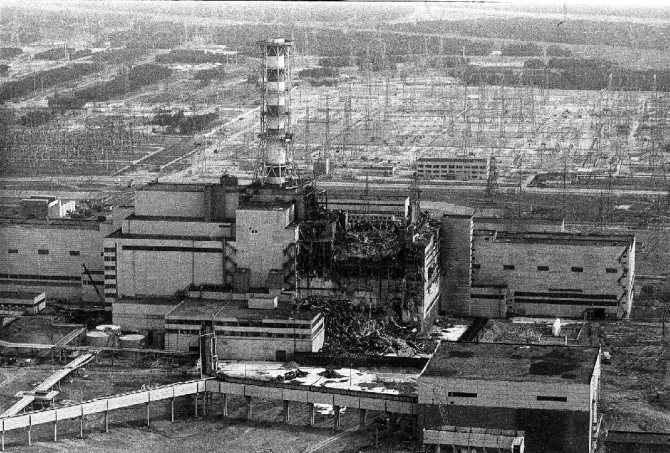
The high speed of processes occurring inside the charge leads to a rapid jump in temperature and an increase in pressure. It is these components that form the nature, factors and power of a nuclear explosion.
How does an atomic bomb work?
A nuclear explosion is a chaotic process of releasing a colossal amount of energy that is formed as a result of a nuclear fission or fusion reaction. Similar and comparable in power processes occur in the interiors of stars.
The nucleus of an atom of any substance divides when it absorbs neutrons, but for most elements of the periodic table this requires significant energy. However, there are elements capable of such a reaction under the influence of neutrons, which have any - even minimal - energy. They are called fissile.
To create nuclear weapons, the isotopes uranium-235 or plutonium-239 are used. The first element is found in the earth's crust, it can be isolated from natural uranium (enrichment), and weapons-grade plutonium is produced artificially in nuclear reactors. There are other fissile elements that can theoretically be used in nuclear weapons, but their production is associated with great difficulties and costs, so they are almost never used.
The main feature of a nuclear reaction is its chain reaction, that is, its self-sustaining nature. When an atom is irradiated with neutrons, it disintegrates into two fragments, releasing a large amount of energy, as well as two secondary neutrons, which, in turn, can cause the fission of neighboring nuclei. So the process becomes cascading. As a result of a nuclear chain reaction, in a short period of time, in a very limited volume, a colossal amount of “fragments” of decayed nuclei and atoms is formed in the form of high-temperature plasma: neutrons, electrons and quanta of electromagnetic radiation. This clot rapidly expands, forming a shock wave of enormous destructive power.
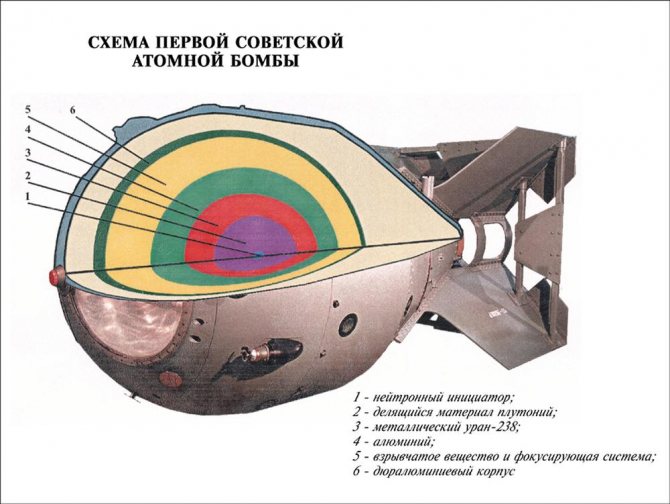
The construction of the first Soviet nuclear bomb
The vast majority of modern nuclear weapons operate not on the basis of a chain reaction of decay, but through the fusion of nuclei of light elements, which begins at high temperatures and enormous pressure. In this case, an even greater amount of energy is released than during the decay of nuclei such as uranium or plutonium, but the result does not fundamentally change - a region of high-temperature plasma is formed. Such transformations are called thermonuclear fusion reactions, and the charges in which they are used are thermonuclear.
Separately, it should be said about special types of nuclear weapons, in which most of the fission (or fusion) energy is directed towards one of the factors of destruction. These include neutron munitions, which generate a stream of hard radiation, as well as the so-called cobalt bomb, which produces maximum radiation contamination of the area.
Types and types of nuclear explosions
The chain reaction that has been started can no longer be stopped. In thousandths of a second, a nuclear charge consisting of radioactive elements turns into a plasma clot, torn apart by high pressure. A sequential chain of a number of other factors begins that have a damaging effect on the environment, infrastructure and living organisms. The difference in damage caused is only that a small nuclear bomb (10-30 kilotons) entails a smaller scale of destruction and less severe consequences than a large nuclear explosion with a power of 100 megatons or more brings.
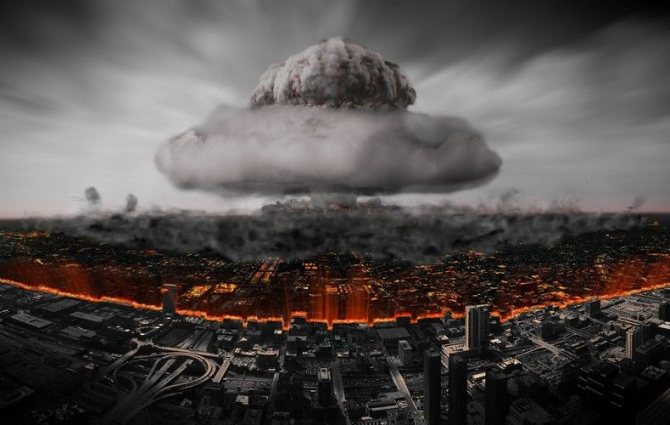
The damaging factors depend not only on the power of the charge. To assess the consequences, the conditions for detonating a nuclear weapon, and what type of nuclear explosion is observed in this case, are important. Detonation of a charge can be carried out on the surface of the earth, underground or under water, according to the conditions of use we are dealing with the following types:
- aerial nuclear explosions carried out at certain heights above the earth's surface;
- high-altitude explosions carried out in the planet’s atmosphere at altitudes above 10 km;
- ground (surface) nuclear explosions carried out directly above the surface of the earth or above the surface of the water;
- underground or underwater explosions carried out in the surface layer of the earth's crust or under water at a certain depth.
In each individual case, certain damaging factors have their own strength, intensity and characteristics of action, leading to certain results. In one case, a targeted destruction of a target occurs with minimal destruction and radioactive contamination of the territory. In other cases, one has to deal with large-scale devastation of the area and destruction of objects, instantaneous destruction of all living things occurs, and severe radioactive contamination of vast areas is observed.

An airborne nuclear explosion, for example, differs from a ground-based detonation in that the fireball does not come into contact with the surface of the earth. In such an explosion, dust and other small fragments are combined into a dust column that exists separately from the explosion cloud. Accordingly, the area affected depends on the height of the detonation. Such explosions can be high or low.
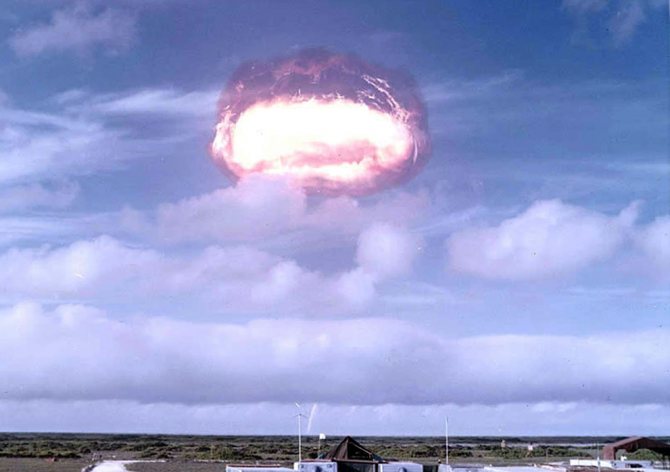
The first tests of atomic warheads in both the USA and the USSR were mainly of three types: ground, air and underwater. Only after the Nuclear Test Limitation Treaty came into force did nuclear explosions in the USSR, the USA, France, China and Great Britain begin to be carried out only underground. This made it possible to minimize environmental pollution by radioactive products and reduce the area of exclusion zones that arose near military training grounds.
The most powerful nuclear explosion carried out in the entire history of nuclear testing took place on October 30, 1961 in the Soviet Union. The bomb, with a total weight of 26 tons and a yield of 53 megatons, was dropped in the area of the Novaya Zemlya archipelago from a Tu-95 strategic bomber. This is an example of a typical high air explosion, since the charge detonated at an altitude of 4 km.
It should be noted that the detonation of a nuclear warhead in the air is characterized by strong exposure to light radiation and penetrating radiation. The flash of a nuclear explosion is clearly visible tens and hundreds of kilometers from the epicenter. In addition to powerful light radiation and a strong shock wave spreading around 3600, the air explosion becomes a source of strong electromagnetic disturbance. An electromagnetic pulse generated during an airborne nuclear explosion within a radius of 100-500 km. capable of destroying all ground-based electrical infrastructure and electronics.
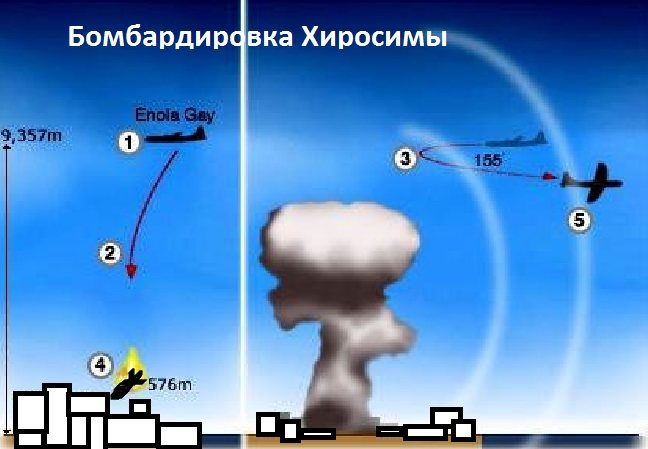
A striking example of a low air explosion was the atomic bombing of the Japanese cities of Hiroshima and Nagasaki in August 1945. The “Fat Man” and “Kid” bombs went off at an altitude of half a kilometer, thereby covering almost the entire territory of these cities with a nuclear explosion. Most of the residents of Hiroshima died in the first seconds after the explosion, as a result of exposure to intense light, heat and gamma radiation. The shock wave completely destroyed city buildings. In the case of the bombing of the city of Nagasaki, the effect of the explosion was weakened by the features of the relief. The hilly terrain allowed some areas of the city to avoid the direct impact of light rays and reduced the impact force of the blast wave. But during such an explosion, extensive radioactive contamination of the area was observed, which subsequently led to serious consequences for the population of the destroyed city.
Low and high air bursts are the most common modern weapons of mass destruction. Such charges are used to destroy concentrations of troops and equipment, cities and ground infrastructure.
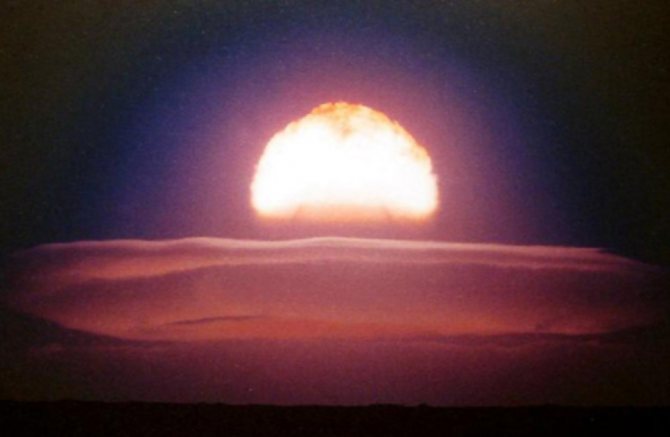
A high-altitude nuclear explosion differs in its method of application and nature of action. A nuclear weapon is detonated at an altitude of more than 10 km, in the stratosphere. With such an explosion, a bright sun-shaped flare of large diameter is observed high in the sky. Instead of clouds of dust and smoke, a cloud soon forms at the site of the explosion, consisting of hydrogen, carbon dioxide and nitrogen molecules evaporated under the influence of high temperatures.
In this case, the main damaging factors are the shock wave, light radiation, penetrating radiation and EMR from a nuclear explosion. The higher the height of the charge detonation, the lower the force of the shock wave. Radiation and light emission, on the contrary, only intensify with increasing altitude. Due to the absence of significant movement of air masses at high altitudes, radioactive contamination of territories in this case is practically reduced to zero. Explosions at high altitudes made within the ionosphere disrupt the propagation of radio waves in the ultrasonic range.
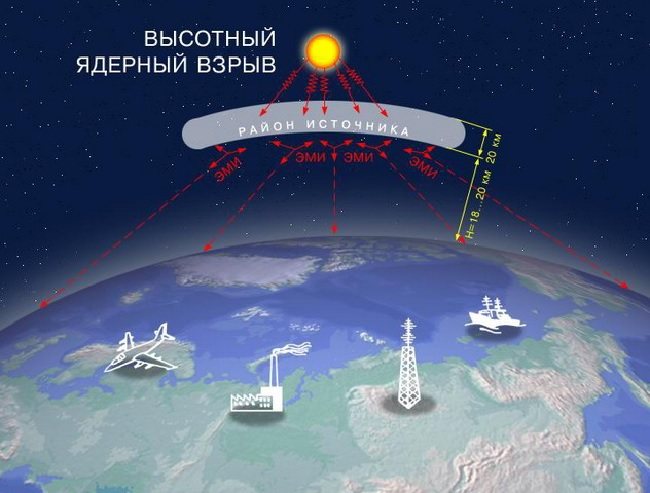
Such explosions are mainly aimed at destroying high-flying targets. These could be reconnaissance aircraft, cruise missiles, strategic missile warheads, artificial satellites and other space attack weapons.
A ground-based nuclear explosion is a completely different phenomenon in military tactics and strategy. Here, a specific area of the earth's surface is directly affected. The detonation of a warhead can be carried out over an object or over water. The first tests of atomic weapons in the USA and the USSR took place in exactly this form.
A distinctive feature of this type of nuclear explosion is the presence of a pronounced mushroom cloud, which is formed due to the huge volumes of soil and rock particles raised by the explosion. At the very first moment, a luminous hemisphere is formed at the site of the explosion, its lower edge touching the surface of the earth. During a contact detonation, a crater is formed at the epicenter of the explosion, where the nuclear charge exploded. The depth and diameter of the crater depends on the power of the explosion itself. When using small tactical ammunition, the diameter of the crater can reach two to three tens of meters. When a nuclear bomb explodes with high power, the size of the crater often reaches hundreds of meters.
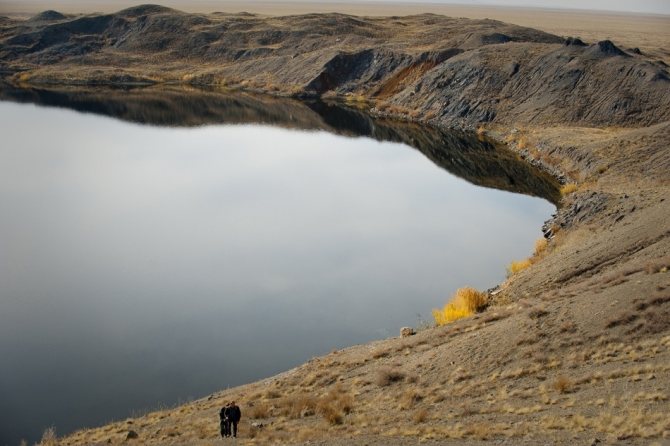
The presence of a powerful mud-dust cloud causes the bulk of the radioactive products of the explosion to fall back onto the surface, making it completely contaminated. Smaller dust particles enter the surface layer of the atmosphere and, together with air masses, are scattered over vast distances. If an atomic charge is detonated on the surface of the earth, the radioactive trace from the resulting ground explosion can stretch for hundreds and thousands of kilometers. During the accident at the Chernobyl nuclear power plant, radioactive particles that entered the atmosphere fell along with precipitation in the Scandinavian countries, which are located 1000 km from the site of the disaster.
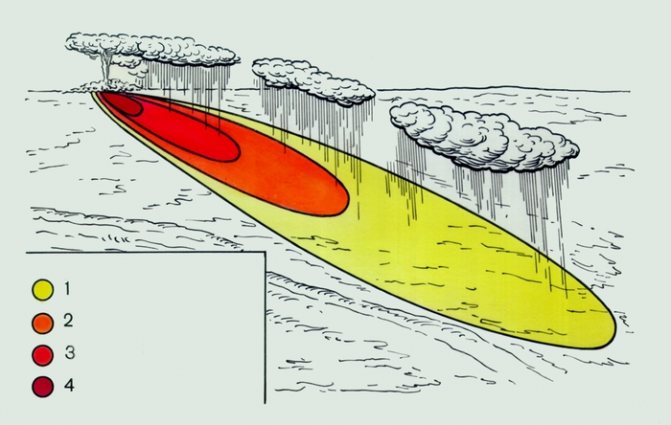
Ground explosions can be carried out to destroy and destroy highly durable objects. Such explosions can also be used if the goal is to create a vast zone of radioactive contamination of the area. In this case, all five damaging factors of a nuclear explosion are in effect. Following the thermodynamic shock and light radiation, an electromagnetic pulse comes into play. The destruction of the object and manpower within the radius of action is completed by a shock wave and penetrating radiation. Last but not least is radioactive contamination. Unlike the ground-based detonation method, a surface nuclear explosion lifts huge masses of water into the air, both in liquid and vapor form. The destructive effect is achieved due to the impact of the air shock wave and the great excitement generated as a result of the explosion. Water raised into the air prevents the spread of light radiation and penetrating radiation. Due to the fact that water particles are much heavier and are a natural neutralizer of elemental activity, the intensity of the spread of radioactive particles in the airspace is insignificant.

An underground explosion of a nuclear weapon is carried out at a certain depth. Unlike ground explosions, there is no glowing area. The earth's rock takes on all the enormous force of the impact. The shock wave diverges through the earth, causing a local earthquake. The enormous pressure created during the explosion forms a column of soil collapse that goes to great depths. As a result of rock subsidence, a crater is formed at the explosion site, the dimensions of which depend on the power of the charge and the depth of the explosion.
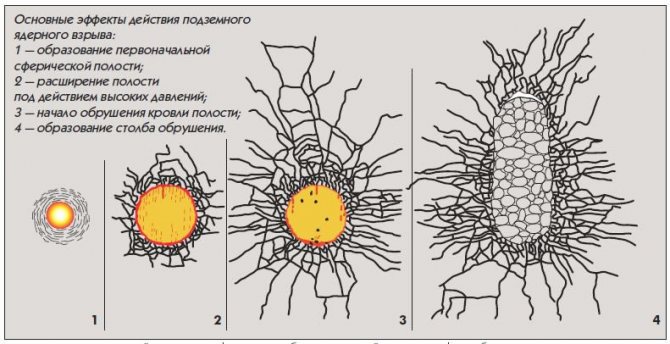
Such an explosion is not accompanied by a mushroom cloud. The column of dust that rose at the site of the charge detonation is only a few tens of meters high. The shock wave, converted into seismic waves, and local surface radioactive contamination are the main damaging factors in such explosions. As a rule, this type of detonation of a nuclear charge has economic and practical significance. Today, most nuclear tests are carried out underground. In the 70-80s, national economic problems were solved in a similar way, using the colossal energy of a nuclear explosion to destroy mountain ranges and form artificial reservoirs.
On the map of nuclear test sites in Semipalatinsk (now the Republic of Kazakhstan) and in the state of Nevada (USA) there are a huge number of craters, traces of underground nuclear tests.
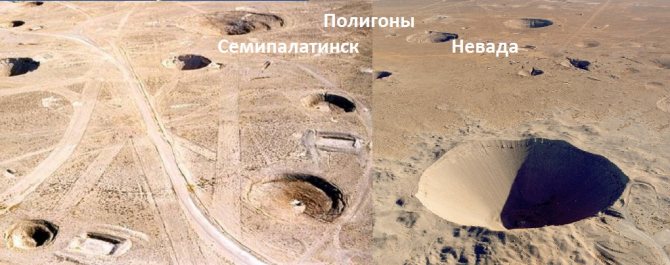
Underwater detonation of a nuclear charge is carried out at a given depth. In this case, there is no light flash during the explosion. On the surface of the water at the site of the explosion, a water column 200-500 meters high appears, which is crowned with a cloud of spray and steam. The formation of a shock wave occurs immediately after the explosion, causing disturbances in the water column. The main damaging factor of the explosion is the shock wave, which transforms into waves of great height. When high-power charges explode, the wave height can reach 100 meters or more. Subsequently, severe radioactive contamination was observed at the site of the explosion and in the surrounding area.
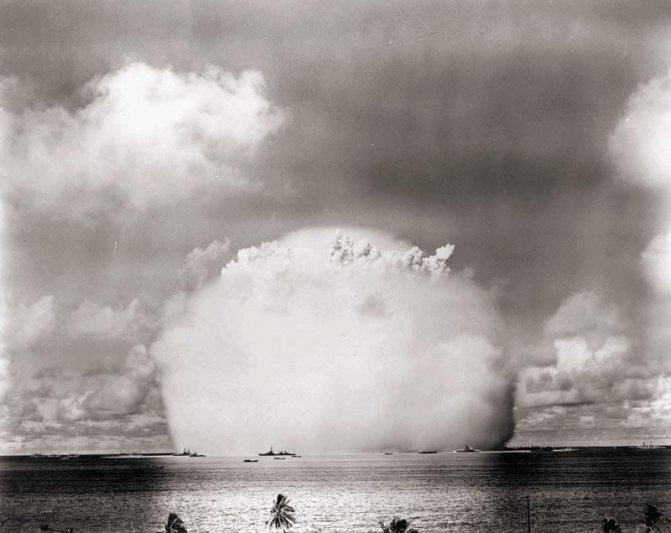
Consequences of a nuclear explosion
The results of atomic explosions can be globally destructive. As a result of numerous bombings, irreparable harm will be caused to life on the planet, including the environment and the ozone layer. Immediately after the impacts, inevitable climate changes begin.
A systematic decrease in temperature is possible. Any type of nuclear explosion releases enormous amounts of ash, dust and small particles into the atmosphere. Clouds and smog form - they become an insurmountable barrier to sunlight. Darkness sets in, the surface of the earth begins to rapidly cool.
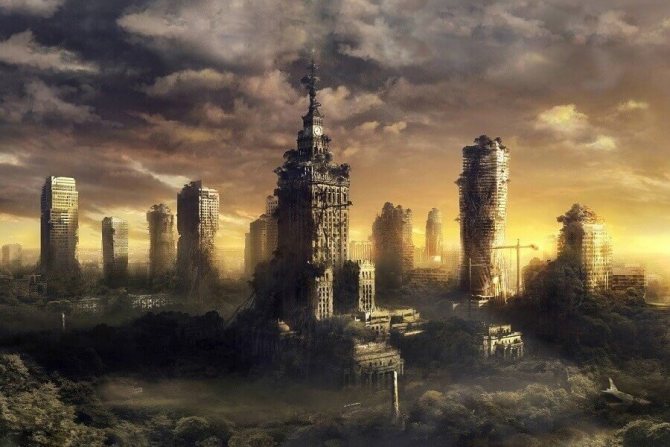
The explosion of an atomic bomb causes massive fires, causing cities to flare up like torches. Soot from fires rushes into the upper atmosphere. It contains hydroxyls and nitrogen oxide; these substances have a powerful destructive effect on the ozone layer. After the pollution dissipates, all living things are exposed to solar and galactic radiation, which causes:
- burns;
- cancer;
- mutation;
- cessation of photosynthesis in plants;
- destruction of the microcosm.
It will take centuries to restore the ozone layer.
The consequences of a nuclear explosion will lead to the mass death of all living things. Extreme cold will have a detrimental effect on tropical flora and fauna. Fish and waterfowl will be left without a food supply - due to the freezing of small reservoirs and coastal zones, the regeneration of plankton will cease. There will be a destruction of energy supplies, communications, and transport links. There will be a shortage of fresh water, food, and medicines. “Nuclear winter” will be a terrible test for those who will not be affected by an atomic explosion.
Methods of protection against damaging factors of a nuclear explosion
As a result of the explosive reaction of a nuclear charge, a huge amount of thermal and light energy is generated, capable of not only destroying and destroying inanimate objects, but killing all living things over a large area. At the epicenter of the explosion and in the immediate vicinity of it, as a result of the intense impact of penetrating radiation, light, thermal radiation and shock waves, all living things die, military equipment is destroyed, buildings and structures are destroyed. With distance from the epicenter of the explosion and over time, the strength of the damaging factors decreases, giving way to the last destructive factor - radioactive contamination.
It is useless to seek salvation for those caught in the epicenter of a nuclear apocalypse. Neither a strong bomb shelter nor personal protective equipment will save you here. Injuries and burns received by a person in such situations are incompatible with life. The destruction of infrastructure facilities is total and cannot be restored. In turn, those who find themselves at a considerable distance from the explosion site can count on salvation using certain skills and special methods of protection.
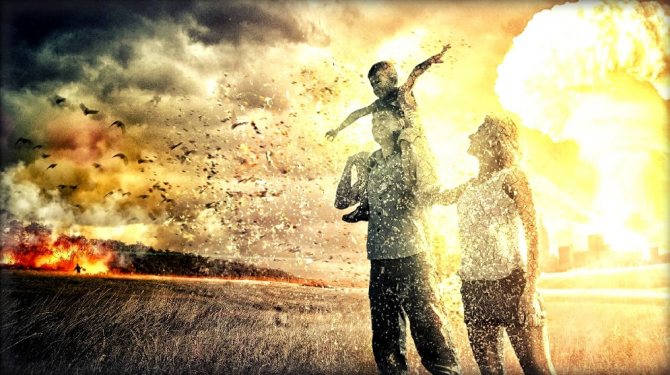
The main damaging factor in a nuclear explosion is the shock wave. The high pressure area formed at the epicenter affects the air mass, creating a shock wave that spreads in all directions at supersonic speed.
The speed of propagation of the blast wave is as follows:
- on flat terrain, the shock wave travels 1000 meters from the epicenter of the explosion in 2 seconds;
- at a distance of 2000 m from the epicenter, the shock wave will overtake you in 5 seconds;
- being at a distance of 3 km from the explosion, the shock wave should be expected after 8 seconds.
After the blast wave passes, an area of low pressure appears. Trying to fill the rarefied space, the air flows in the opposite direction. The created vacuum effect causes another wave of destruction. Having seen the flash, you can try to find shelter before the blast wave arrives, reducing the effects of the shock wave.
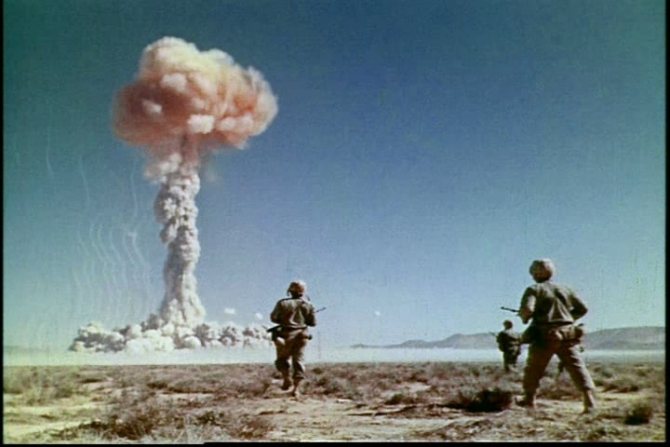
Light and thermal radiation lose their power at a great distance from the epicenter of the explosion, so if a person managed to take cover at the sight of the flash, one can count on salvation. Much more dangerous is penetrating radiation, which is a rapid stream of gamma rays and neutrons that spread at the speed of light from the luminous area of the explosion. The most powerful impact of penetrating radiation occurs in the first seconds after the explosion. While in a shelter or shelter, there is a high probability of avoiding direct exposure to deadly gamma radiation. Penetrating radiation causes severe damage to living organisms, causing radiation sickness.
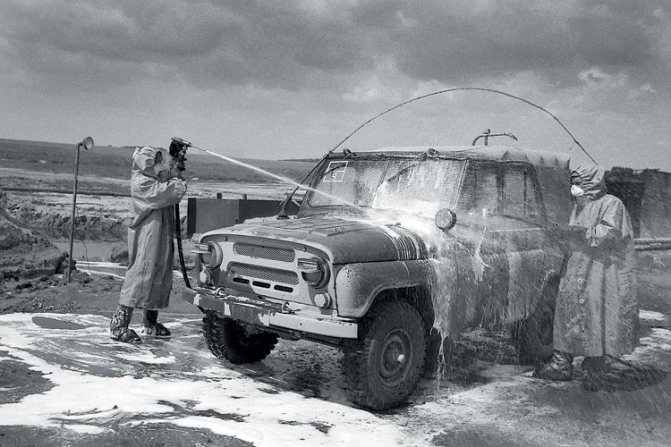
If all the previous listed damaging factors of a nuclear explosion are short-term in nature, then radioactive contamination is the most insidious and dangerous factor. Its destructive effect on the human body occurs gradually over time. The amount of residual radiation and the intensity of radioactive contamination depend on the power of the explosion, terrain conditions and climatic factors. The radioactive products of the explosion, mixing with dust, small fragments and fragments, enter the ground air layer, after which, together with precipitation or independently, they fall to the surface of the earth. The radiation background in the zone where nuclear weapons are used is hundreds of times higher than the natural radiation background, creating a threat to all living things. While in an area that has been subjected to a nuclear attack, you should avoid contact with any objects. Personal protective equipment and a dosimeter will reduce the likelihood of radioactive contamination.
Why are atomic weapons dangerous and how to protect yourself from them?
The main damaging factors of a nuclear explosion:
- light radiation;
- shock wave;
- penetrating radiation;
- contamination of the area;
- electromagnetic pulse.
If we talk about a ground explosion, then half of its energy (50%) goes to the formation of a shock wave and a crater, approximately 30% comes from the light radiation of a nuclear explosion, 5% from an electromagnetic pulse and penetrating radiation, and 15% from contamination of the area.

Hiroshima after the bombing
Light radiation from a nuclear explosion is one of the main damaging factors of nuclear weapons. It is a powerful stream of radiant energy, which includes radiation from the ultraviolet, infrared and visible parts of the spectrum. Its source is an explosion cloud in the early stages of existence (a fireball). At this time, it has a temperature of 6 to 8 thousand °C.
Light radiation spreads almost instantly, the duration of this factor is calculated in seconds (up to a maximum of 20 seconds). But, despite the short duration, light radiation is very dangerous. At a short distance from the epicenter, it burns all combustible materials, and at a distance it leads to large-scale fires and fires. Even at a considerable distance from the explosion, damage to the organs of vision and burns to the skin is possible.
Since radiation travels in a straight line, any opaque barrier can provide protection from it. This damaging factor is significantly weakened in the presence of smoke, fog or dust.
The shock wave of a nuclear explosion is the most dangerous factor in nuclear weapons. Most injuries to people, as well as destruction and damage to objects occur precisely due to its effects. A shock wave is an area of sharp compression of a medium (water, soil or air), which moves in all directions from the epicenter. If we talk about an atmospheric explosion, the shock wave speed is 350 m/s. As the distance increases, its speed quickly decreases.
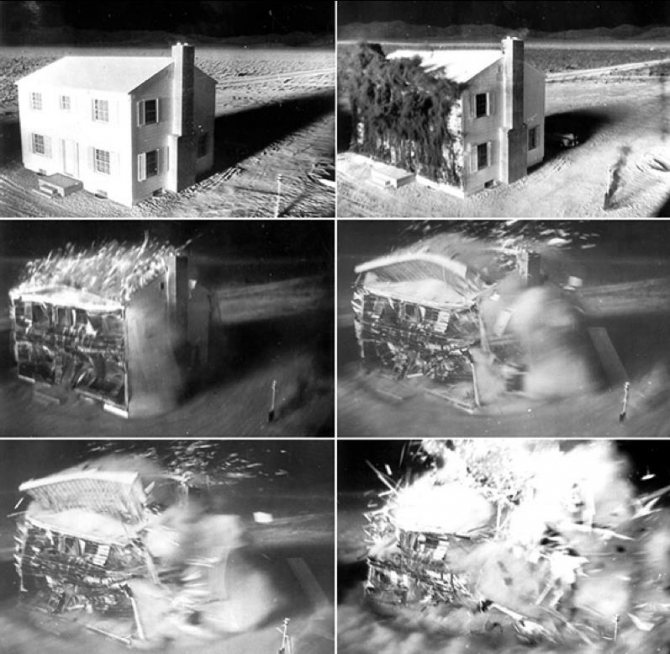
The shock wave of a nuclear explosion demolishes a building. Footage taken during the exercise
This damaging factor has a direct impact due to excess pressure and speed, and a person can also suffer from various debris that it carries. Closer to the epicenter, the wave causes serious seismic vibrations that can collapse underground structures and communications.
It should be understood that neither buildings nor even special shelters can protect against a shock wave in the immediate vicinity of the epicenter. However, they are quite effective at a considerable distance from it. The destructive power of this factor is significantly reduced by terrain folds.
Penetrating radiation. This damaging factor is a stream of hard radiation, which consists of neutrons and gamma rays, emitted from the epicenter of the explosion. Its effect, like that of light radiation, is short-lived because it is strongly absorbed by the atmosphere. Penetrating radiation is dangerous within 10-15 seconds after a nuclear explosion. For the same reason, it is capable of affecting humans only at a relatively short distance from the epicenter - 2-3 km. As you move away from it, the level of radioactive exposure quickly drops.
Passing through the tissues of our body, a stream of particles ionizes molecules, disrupting the normal course of biological processes, which leads to failure of the most important systems of the body. With severe damage, radiation sickness occurs. This factor has a destructive effect on some materials, and also disables electronic and optical devices.
Absorbing materials are used to protect against penetrating radiation. For gamma radiation, these are heavy elements with significant atomic mass: for example, lead or iron. However, these substances do not capture neutrons well; moreover, these particles cause induced radioactivity in metals. Neutrons, in turn, are well absorbed by light elements such as lithium or hydrogen. For comprehensive protection of objects or military equipment, multilayer materials are used. For example, the heads of ICBM mine installations are shielded using reinforced concrete and lithium containers. When constructing nuclear shelters, boron is often added to building materials.
Electromagnetic pulse. A damaging factor that does not affect the health of humans or animals, but disables electronic devices.
A powerful electromagnetic field arises after a nuclear explosion as a result of the impact of hard radiation on the atoms of the environment. Its effect is short-lived (a few milliseconds), but it is still enough to damage equipment and power lines. Strong ionization of the air disrupts the normal operation of radio communications and radar, so the detonation of nuclear weapons is used to blind the missile attack warning system.
An effective way to protect against EMR is to shield electronic equipment. It has been used in practice for many decades.
Radiation contamination. The source of this damage factor is the products of nuclear reactions, the unused part of the charge, as well as induced radiation. Contamination from a nuclear explosion poses a serious danger to human health, especially since the half-life of many isotopes is very long.
Contamination of air, terrain and objects occurs as a result of the fallout of radioactive substances. They settle along the way, forming a radioactive trace. Moreover, as you move away from the epicenter, the danger decreases. And, of course, the area of the explosion itself becomes a contamination zone. Most hazardous substances fall out in the form of precipitation within 12-24 hours after the explosion.
The main parameters of this factor are the radiation dose and its power.
Radioactive products are capable of emitting three types of particles: alpha, beta and gamma. The first two do not have serious penetrating ability, so they pose less of a threat. The greatest danger is the possible ingress of radioactive substances into the body along with air, food and water.
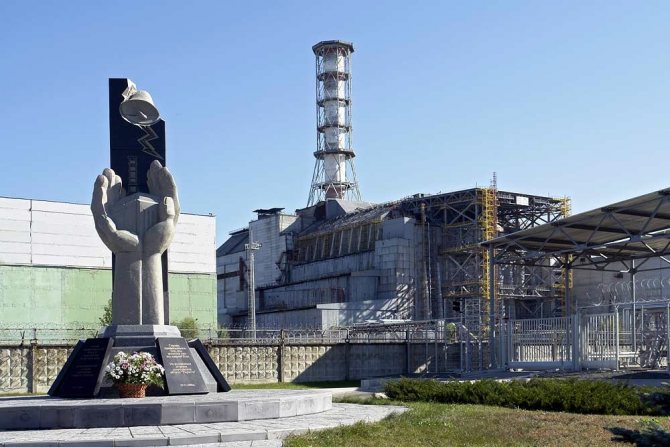
The Chernobyl nuclear power plant is the site of the worst man-made accident in human history
The best way to protect against radioactive products is to completely isolate people from their exposure. After the use of nuclear weapons, a map of the area must be created indicating the most contaminated areas, visiting which is strictly prohibited. It is necessary to create conditions that prevent unwanted substances from entering water or food. People and equipment visiting contaminated areas must undergo decontamination procedures. Another effective way is personal protective equipment: gas masks, respirators, OZK suits.
The truth is that various methods of protecting yourself from a nuclear explosion can only save your life if you are far enough from its epicenter. In its immediate vicinity, everything will be turned into fine melted rubble, and any shelters will be destroyed by seismic vibrations.
In addition, a nuclear attack will certainly lead to the destruction of infrastructure, panic, and the development of infectious diseases. Such phenomena can be called a secondary damaging factor of nuclear weapons. A nuclear explosion at a nuclear power plant can lead to even more severe results. In this case, tons of radioactive isotopes will be released into the environment, some of which have a long half-life.
As the tragic experiences of Hiroshima and Nagasaki showed, a nuclear explosion not only kills people and mutilates their bodies, but also causes severe psychological trauma to the victims. The apocalyptic spectacles of the post-nuclear landscape, large-scale fires and destruction, the abundance of bodies and the groans of charred dying people cause incomparable mental suffering in humans. Many of those who survived the nightmare of nuclear bombings in the future were unable to get rid of serious mental disorders. In Japan, a special name was invented for this category - “Hibakusha”.
